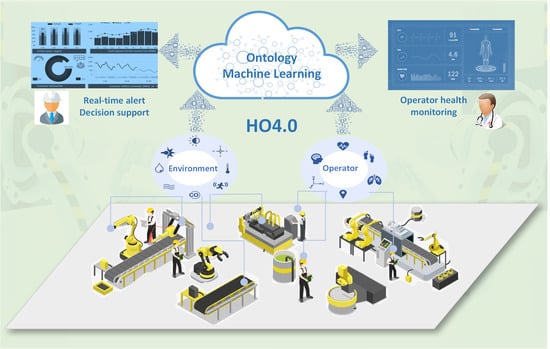Healthy Operator 4.0: A Human Cyber–Physical System Architecture for Smart Workplaces
Abstract
1. Introduction
- Empowering people to dynamically interact with machines in both the cyber and physical worlds to fit the operators’ cognitive and physical needs supported by intelligent human–computer interaction techniques;
- Improving the physical, sensing, and cognitive capabilities of people taking advantages from diverse technologies, such as IoT and wearable technologies.
- Virtual operator, enabled by virtual reality (VR)/augmented reality (AR) [18],
- Super-strength operator, enabled by exoskeletons [19],
- Smarter operator, enabled by intelligent personal assistant (IPA)-based solutions [20],
- Healthy operator, enabled by wearable technologies combined with advanced data analytic techniques [21],
- etc.
- Formally define the HO4.0 concept, by carefully analyzing the contributions from previous research in relevant fields,
- Propose a HO4.0 application framework enabling relevant data integration in highly dynamic work environments, supported by the IIoT and wearable technology. According to the definitions, we presented a multi-layer architecture and an implementation framework to guide the their application in industry;
- Provide a prototype system, developed according to the proposed framework, where the assessment of its capabilities can be derived; and
- Conduct experiments to verify the capabilities of the prototype system to provide new knowledge on real applications.
2. HO4.0 Concept
3. HO4.0 Framework
3.1. Proposed Architecture
- Smart Connection layer: Accurate and reliable data from operators, machines, the ambient environment, and other parts of the production system are the foundation of the HO4.0 system. The sensing layer collected these data utilizing wearable devices, ambient sensors, and the industrial sensors of manufacturing systems etc. Wearable devices, such as smart watches, smart bands, smart glasses, smart shoes, and smart helmets, contain a variety of sensors that can measure the operator’s location, movements, heart rate, blood pressure, body temperature, concentration level (e.g., fatigue), foot pressure, etc. Stationary or portable ambient sensors, such as air quality, thermal (temperature and humidity) sensors, and acoustic and light sensors, are used to monitor the conditions of the workplace environment surroundings, such as the indoor air quality level, temperature, humidity, pollutant concentration, light intensity, and noise levels. The indoor positioning system (IPS) was adopted to detect the movement and location of the operators, vehicles, work pieces, machines, etc. in a workplace.
- Integration and Communication layer: This layer was mainly composed of edge computing devices or gateways, which could include a smartphone, tablet, router, or single-board computer (SBC) etc. This layer was required due to the limitations of the size, power supply, and computing capabilities of most wearable devices and ambient sensors from the sensing layer. They are not capable of performing operations such as data filtering and integration. This layer aimed to filter and integrate these diverse data, and if necessary, to convert and pre-process the raw data based on different data modeling approaches. The sensors used in the sensing layer are from many domains, e.g., monitoring human psychological behaviors and detecting environmental conditions. This layer also facilitated the data uploading to the server storage for further data analysis. The edge computing device in this layer can be applied to provide real-time health warnings that are critical for a human that interacts with machines and HCPSs.
- Modeling layer: The health related data was fused and modeled in this layer. The twin model of operator health was created and relevant simulations can be run to apply the derived high lever rules. This is typically conducted in a local or remote/cloud server with a higher computing capability that is able to care about data streams from different communication devices. Semantic data description enables the interoperability and usage of semantic models, and knowledge graphs might also be employed to facilitate the knowledge extraction. Supported by advanced machine learning techniques and semantic-driven data fusion, useful knowledge, such as risk alerts, improved advice, and rules, can be extracted.
- Cognition layer: Based on the results from the model layer, the cognition layer can provide hints and insights from cyber space to physical space and acts as a monitoring system for the preventive decisions from operators, machines, or ambient environments. On this layer, analyzing the results can support the decision-making and can be presented with proper data visualization techniques. Certain user interfaces, applets, or web-based services can be also implemented. The alerts, advice, and orders can be delivered to different stakeholders to help them conduct corresponding actions. The target is to ensure work–life health, safety, and satisfaction.
3.2. Enabling Technologies
- Wearable technology: Wearable technology or wearable computing is the study or practice of inventing, designing, building, or using miniature body-worn computational and sensory devices [35]. With the rapid development of sensing technologies, various types of sensors can be embedded in wearable devices. According to their features, they can be divided into four major groups [36]:
- Environmental sensors, such as light sensors, temperature sensors, sound sensors, humidity sensors, air quality sensors (e.g., CO2 sensors, particulate matter (PM) sensors, and volatile organic components (VOCs) sensors), and barometric sensors.
- Biosensors, including body temperature sensors, heart-rate-monitoring sensors, electrocardiogram (ECG), electroencephalography (EEG), electromyography (EMG) sensors, blood pressure sensors, galvanic skin response (GSR) sensors, eye tracking, weight insole, and glucose level sensors.
- Location tracking sensors, such as GPS, altimeters, magnetometers, compasses, and accelerometers.
- Other sensors, including camera sensors, communication sensors, ultrasonic sensors, infrared receiver (IR), sensors.
The application of wearable technologies in HCPSs provides rich information related to the operators and the surrounding environment. - Indoor Positioning System: IPSs locate and track objects within a closed environment usually based on triangulation and multilateration methods using light, ultrasound, or radio signals to provide positional information [37]. The tracking of operators and production equipment can be significantly improved by the application of IPS [13]. Several wireless technologies might be used in IPS depending on the application situations by means of different positioning algorithms [38], such as Global Positioning System (GPS), Radio Frequency IDentification (RFID), Cellular networks, Ultra-wideband (UWB), wireless local area network (WLAN), Bluetooth etc. The adoption of IPS makes possible of a context-aware system for HO4.0 to help operators monitor the locations of machines, vehicles and workpieces to improve productivity and avoid potential collision risks.
- Ambient environment monitoring: The condition of the ambient environment plays a crucial role in a HO4.0 system. It may impact the operators’ working performance or even harm their health. For example, indoor air pollution is one of the leading environmental risks, and indoor air quality (IAQ) is proven to have significant impacts on human comfort, health, and performance [29]. The advancement of low-cost IoT sensors, in recent years, has enabled the use of wireless communications and computing for interacting with the physical world. These sensors can measure indoor environmental parameters including IAQ, comfort, lighting, and acoustic conditions [39,40,41]. Many of these low-cost ambient sensors allow portable deployment and different sensors can be easily packed in one board to fit the requirements of different application scenarios. The data generated by such sensors can be collected by certain edge computing devices, such as single board computers (SBC). As an example, an ambient environment monitoring system based on a sensor island and a Raspberry Pi SBC was developed in a previous study [29]. The sensor island used in this system was composed of nine different ambient sensors to monitor different aspects of the ambient environment. More details of this system are explained in the prototyping section.
- Knowledge engineering: A semantic data model is a high-level representation of knowledge. It is designed to capture the meaning of data attributes and relationships, and obtain the meaning of each instance in an application context. The standard data model and knowledge engineering facilitates information exchange and data interpretation in a very heterogeneous data sources. Fusion and integration data based on rich semantic context gravitates toward applications, such as effective decision making processes, by fully making use of the various heterogeneous data. Ontologies, stemming from the Semantic Web, are used to define standard and common terms, vocabulary, and relationships for a particular area/domain. Aligning on common interpretations through ontologies, data/knowledge graphs can be generated to refer to the relationships among different data sources from different domains. Existing or adapted ontologies [42,43] are recommended to be used for semantic modeling aiming to derive action rules toward the operator’s health management.
- Machine learning (ML): The data gathered from the sensing layer can contain valuable information, which is the core of the HO4.0 system. Indeed, when scaled up appropriately, it can become a large volume of data; whereas, a global analysis can help in providing better interpretations for the impact of different behaviors. Therefore, advanced data modeling tools, such as machine learning, can be useful to create or emphasize such new knowledge. The wide applications of the IoT have promoted the concept of big data, which on the other hand, has fostered the explosive involvement of the advanced machine learning techniques represented by deep learning. Despite the great achievement of machine learning in many fields, its power has not been fully and systematically explored in the industry sector, particularly in the human-centric systems. Here the benefits from the adopted concept for HO4.0, such as the system proposed in this research (which enables the digital twin approach) facilitates modeling capabilities to detect patterns and to add value in the real world for human-centric applications. For example, deep learning can be used to monitor an operator’s activities based on the motion data collected from wearable devices [9,44,45], but when combined with health related information and environmental conditions, this can provide a health index for such activities. In addition to the self learning process based on the real time data, the inter-comparison between workers would help to better understand the physiological and mental demands, but it can also help to find different patterns and to learn about the sustainability of them for the long term [46].
4. The Application Case and Experiments
4.1. Case Selection
4.2. Sensing Layer
- Environmental conditions, including temperature, humidity, and noise, as they can impact the operators’ health, as well as their performance.
- Heart rate, as related to their physical or mental effort.
- Blood Pressure, also as related to their physical or mental effort.
- Arm angle, referring to the horizontal line, as a reference for ergonomic working activities.
- Position, as a reference for understanding the movements and knowledge requirements in order to complete the work.
- Steps, as a reference for the physical effort.
- Crane position, in relation to the crane operator movements, allowing us to identify the effective working time.
4.3. Integration and Communication Layer
4.4. Modeling Layer
5. Results
6. Discussion
7. Conclusions
- We explored the HO4.0 concept.
- Based on the classical five-level CPS structure, we proposed a four-layer framework for the implementation of the HO4.0 concept.
- We investigated of the enabling technologies for HO4.0.
- We developed a prototype system to showcase the application process of the proposed framework.
- We applied advanced machine learning and preparation with semantic engineering technologies to manage and analyze heterogeneous data from different sources, bringing this support to the digital twin perspective.
Author Contributions
Funding
Acknowledgments
Conflicts of Interest
Abbreviations
| AI | Artificial Intelligence. |
| CIM | Computer Integrated Manufacturing. |
| CPS | Cyber–Physical Systems. |
| ECG | Electrocardiogram. |
| EEG | Electroencephalography. |
| EMG | Electromyography. |
| GPS | Positioning System. |
| HCPSs | Human-Cyber–Physical Systems. |
| HO4.0 | Healthy Operator 4.0. |
| IAQ | Indoor Air Quality. |
| IIoT | Industrial Internet of Things. |
| IoT | Internet of Things. |
| IPA | Intelligent Personal Assistant. |
| IPS | Indoor Positioning System. |
| IR | Infrared Receiver. |
| IT | Information Technology. |
| MAC | Media Access Control |
| ML | Machine Learning |
| OSH | Occupational Safety and Health |
| RFID | Radio Frequency IDentification. |
| SBC | Single-Board Computer. |
| TLV | Threshold Limit Value |
| UWB | Ultra-wideband. |
| VR | Virtual Reality. |
| WLAN | wireless local area network. |
References
- Schmidt, R.; Möhring, M.; Härting, R.C.; Reichstein, C.; Neumaier, P.; Jozinović, P. Industry 4.0-potentials for creating smart products: Empirical research results. In International Conference on Business Information Systems; Springer: London, UK, 2015; pp. 16–27. [Google Scholar]
- Pereira, A.; Romero, F. A review of the meanings and the implications of the Industry 4.0 concept. Procedia Manuf. 2017, 13, 1206–1214. [Google Scholar] [CrossRef]
- Zheng, X.; Sun, S.; Mukkamala, R.R.; Vatrapu, R.; Ordieres-Meré, J. Accelerating health data sharing: A solution based on the internet of things and distributed ledger technologies. J. Med. Internet. Res. 2019, 21, e13583. [Google Scholar] [CrossRef] [PubMed]
- Lee, J.; Bagheri, B.; Kao, H.A. A cyber-physical systems architecture for industry 4.0-based manufacturing systems. Manuf. Lett. 2015, 3, 18–23. [Google Scholar] [CrossRef]
- Chen, S.L.; Chen, Y.Y.; Hsu, C. A new approach to integrate internet-of-things and software-as-a-service model for logistic systems: A case study. Sensors 2014, 14, 6144–6164. [Google Scholar] [CrossRef] [PubMed]
- Glaessgen, E.; Stargel, D. The Digital Twin Paradigm for Future NASA and US Air Force Vehicles. In Proceedings of the 53rd AIAA/ASME/ASCE/AHS/ASC Structures, Structural Dynamics and Materials Conference 20th AIAA/ASME/AHS Adaptive Structures Conference 14th AIAA, Honolulu, HI, USA, 23–26 April 2012; p. 1818. [Google Scholar]
- Boschert, S.; Rosen, R. Digital twin—The simulation aspect. In Mechatronic Futures; Springer: London, UK, 2016; pp. 59–74. [Google Scholar]
- Hao, Y.; Helo, P. The role of wearable devices in meeting the needs of cloud manufacturing: A case study. Robot. Comput.-Integr. Manuf. 2017, 45, 168–179. [Google Scholar] [CrossRef]
- Zheng, X.; Wang, M.; Ordieres-Meré, J. Comparison of data preprocessing approaches for applying deep learning to human activity recognition in the context of industry 4.0. Sensors 2018, 18, 2146. [Google Scholar] [CrossRef] [PubMed]
- Putnik, G. Advanced manufacturing systems and enterprises: Cloud and ubiquitous manufacturing and an architecture. J. Appl. Eng. Sci. 2012, 10, 127–134. [Google Scholar]
- Gorecky, D.; Schmitt, M.; Loskyll, M.; Zühlke, D. Human-Machine-Interaction in the Industry 4.0 Era. In Proceedings of the 2014 12th IEEE International Conference on Industrial Informatics (INDIN), Porto Alegre, RS, Brazil, 27–30 July 2014; pp. 289–294. [Google Scholar]
- Romero, D.; Stahre, J.; Wuest, T.; Noran, O.; Bernus, P.; Fast-Berglund, Å.; Gorecky, D. Towards an Operator 4.0 Typology: A Human-Centric Perspective on the Fourth Industrial Revolution Technologies. In Proceedings of the International Conference on Computers and Industrial Engineering (CIE46) Proceedings, Tianjin, China, 29–31 October 2016. [Google Scholar]
- Ruppert, T.; Jaskó, S.; Holczinger, T.; Abonyi, J. Enabling technologies for operator 4.0: A survey. Appl. Sci. 2018, 8, 1650. [Google Scholar] [CrossRef]
- Lorenz, M.; Rüßmann, M.; Strack, R.; Lueth, K.L.; Bolle, M. Man and Machine in Industry 4.0: How Will Technology Transform the Industrial Workforce through 2025; Boston Consulting Group: Boston, MA, USA, 2015; Volume 2. [Google Scholar]
- Romero, D.; Bernus, P.; Noran, O.; Stahre, J.; Fast-Berglund, Å. The operator 4.0: Human cyber-physical systems & adaptive automation towards human-automation symbiosis work systems. In IFIP International Conference on Advances in Production Management Systems; Springer: London, UK, 2016; pp. 677–686. [Google Scholar]
- Tzafestas, S. Concerning human-automation symbiosis in the society and the nature. Int. J. Fact. Autom. Robot. Soft Comput. 2006, 1, 16–24. [Google Scholar]
- Villalba-Díez, J.; Ordieres-Meré, J. Improving manufacturing operational performance by standardizing process management. Trans. Eng. Manag. 2015, 62, 351–360. [Google Scholar] [CrossRef]
- Horváth, L.; Rudas, I.J. Role of Information Content in Multipurpose Virtual Engineering Space. In Proceedings of the 2017 IEEE 15th International Symposium on Applied Machine Intelligence and Informatics (SAMI), Her’lany, Slovakia, 26–28 January 2017; pp. 000099–000104. [Google Scholar]
- Sylla, N.; Bonnet, V.; Colledani, F.; Fraisse, P. Ergonomic contribution of ABLE exoskeleton in automotive industry. Int. J. Ind. Ergon. 2014, 44, 475–481. [Google Scholar] [CrossRef]
- Myers, K.; Berry, P.; Blythe, J.; Conley, K.; Gervasio, M.; McGuinness, D.L.; Morley, D.; Pfeffer, A.; Pollack, M.; Tambe, M. An intelligent personal assistant for task and time management. AI Mag. 2007, 28, 47. [Google Scholar]
- Romero, D.; Mattsson, S.; Fast-Berglund, Å.; Wuest, T.; Gorecky, D.; Stahre, J. Digitalizing occupational health, safety and productivity for the operator 4.0. In IFIP International Conference on Advances in Production Management Systems; Springer: London, UK, 2018; pp. 473–481. [Google Scholar]
- Buffet, M.; Gervais, R.; Liddle, M.; Eeckelaert, L. Well-being at work: Creating a positive work environment. In Literature Review; European Agency for Safety and Health at Work: Bilbao, Spain, 2013. [Google Scholar]
- Salanova, M.; Del Líbano, M.; Llorens, S.; Schaufeli, W.B. Engaged, workaholic, burned-out or just 9-to-5? Toward a typology of employee well-being. Stress Health 2014, 30, 71–81. [Google Scholar] [CrossRef] [PubMed]
- Vasic, M.; Billard, A. Safety Issues in Human-Robot Interactions. In Proceedings of the 2013 IEEE International Conference on Robotics and Automation, Karlsruhe, Germany, 6–10 May 2013; pp. 197–204. [Google Scholar]
- Matthias, B.; Oberer-Treitz, S.; Staab, H.; Schuller, E.; Peldschus, S. Injury Risk Quantification for Industrial Robots in Collaborative Operation with Humans. In Proceedings of the ISR 2010 (41st International Symposium on Robotics) and ROBOTIK 2010 (6th German Conference on Robotics), Munich, Germany, 7–9 June 2010; pp. 1–6. [Google Scholar]
- Page, K.M.; Vella-Brodrick, D.A. The ‘what’,‘why’and ‘how’of employee well-being: A new model. Soc. Indic. Res. 2009, 90, 441–458. [Google Scholar] [CrossRef]
- Podgorski, D.; Majchrzycka, K.; Dąbrowska, A.; Gralewicz, G.; Okrasa, M. Towards a conceptual framework of OSH risk management in smart working environments based on smart PPE, ambient intelligence and the Internet of Things technologies. Int. J. Occup. Saf. Ergon. 2017, 23, 1–20. [Google Scholar] [CrossRef]
- Bernal, G.; Colombo, S.; Al Ai Baky, M.; Casalegno, F. Safety++: Designing IoT and Wearable Systems for Industrial Safety through a User Centered Design Approach. In Proceedings of the 10th International Conference on Pervasive Technologies Related to Assistive Environments, Rhodes, Greece, 21–23 June 2017; pp. 163–170. [Google Scholar]
- Sun, S.; Zheng, X.; Villalba-Díez, J.; Ordieres-Meré, J. Indoor air-quality data-monitoring system: Long-term monitoring benefits. Sensors 2019, 19, 4157. [Google Scholar] [CrossRef]
- Kassner, L.; Hirmer, P.; Wieland, M.; Steimle, F.; Königsberger, J.; Mitschang, B. The Social Factory: Connecting People, Machines and Data in Manufacturing for Context-Aware Exception Escalation. In Proceedings of the 50th Hawaii International Conference on System Sciences, Village, HI, USA, 4–7 January 2017. [Google Scholar]
- Romero, D.; Wuest, T.; Stahre, J.; Gorecky, D. Social factory architecture: Social networking services and production scenarios through the social internet of things, services and people for the social operator 4.0. In IFIP International Conference on Advances in Production Management Systems; Springer: London, UK, 2017; pp. 265–273. [Google Scholar]
- Pavón, I.; Sigcha, L.; Arezes, P.; Costa, N.; De Arcas, G.; Lopez-Navarro, J. Wearable technology for occupational risk assessment: Potential avenues for applications. Occup. Saf. Hyg. VI 2018, 447–452. [Google Scholar]
- Perera, C.; Liu, C.H.; Jayawardena, S. The emerging internet of things marketplace from an industrial perspective: A survey. IEEE Trans. Emerg. Top. Comput. 2015, 3, 585–598. [Google Scholar] [CrossRef]
- Bell, E.; Bryman, A.; Harley, B. Business Research Methods; Oxford University Press: Oxford, UK, 2018. [Google Scholar]
- Mann, S. Wearable computing. In The Encyclopedia of Human-Computer Interaction, 2nd ed.; International Design Foundation: New York, NY, USA, 2013. [Google Scholar]
- Mardonova, M.; Choi, Y. Review of wearable device technology and its applications to the mining industry. Energies 2018, 11, 547. [Google Scholar] [CrossRef]
- Koyuncu, H.; Yang, S.H. A survey of indoor positioning and object locating systems. IJCSNS Int. J. Comput. Sci. Netw. Secur. 2010, 10, 121–128. [Google Scholar]
- Liu, H.; Darabi, H.; Banerjee, P.; Liu, J. Survey of wireless indoor positioning techniques and systems. IEEE Trans. Syst. Man Cybern. Part C (Appl. Rev.) 2007, 37, 1067–1080. [Google Scholar] [CrossRef]
- Zanni, S.; Lalli, F.; Foschi, E.; Bonoli, A.; Mantecchini, L. Indoor air quality real-time monitoring in airport terminal areas: An opportunity for sustainable management of micro-climatic parameters. Sensors 2018, 18, 3798. [Google Scholar] [CrossRef] [PubMed]
- Zakaria, N.A.; Abidin, Z.Z.; Harum, N.; Hau, L.C.; Ali, N.S.; Jafar, F.A. Wireless Internet of Things-based air quality device for smart pollution monitoring. Int. J. Adv. Comput. Sci. Appl. 2018, 9, 65–69. [Google Scholar] [CrossRef]
- Benammar, M.; Abdaoui, A.; Ahmad, S.; Touati, F.; Kadri, A. A modular IoT platform for real-time indoor air quality monitoring. Sensors 2018, 18, 581. [Google Scholar] [CrossRef]
- Industrial Ontologies Foundry (IOF). Available online: https://sites.google.com/view/industrialontologies/home (accessed on 20 March 2020).
- Sampath Kumar, V.R.; Khamis, A.; Fiorini, S.; Carbonera, J.; Olivares-Alarcos, A.; Habib, M.; Gonçalves, P.; Li, H.; Olszewska, J. Ontologies for Industry 4.0. Knowl. Eng. Rev. 2019, 34. [Google Scholar] [CrossRef]
- Ward, J.A.; Lukowicz, P.; Troster, G.; Starner, T.E. Activity recognition of assembly tasks using body-worn microphones and accelerometers. IEEE Trans. Pattern Anal. Mach. Intell. 2006, 28, 1553–1567. [Google Scholar] [CrossRef]
- Shoaib, M.; Bosch, S.; Incel, O.; Scholten, H.; Havinga, P. Complex human activity recognition using smartphone and wrist-worn motion sensors. Sensors 2016, 16, 426. [Google Scholar] [CrossRef]
- Ordieres-Meré, J.; Prieto Remón, T.; Rubio, J. Digitalization: An opportunity for contributing to sustainability from knowledge creation. Sustainability 2020, 12, 1460. [Google Scholar] [CrossRef]
- Macoir, N.; Bauwens, J.; Jooris, B.; Van Herbruggen, B.; Rossey, J.; Hoebeke, J.; De Poorter, E. Uwb localization with battery-powered wireless backbone for drone-based inventory management. Sensors 2019, 19, 467. [Google Scholar] [CrossRef]
- Mobile Operating System Market Share Worldwide. Available online: https://gs.statcounter.com/os-market-share/mobile/worldwide (accessed on 20 March 2020).
- García Paredes, J.; Ordieres-Meré, J. Healthy Operator 4.0. 2020. Available online: https://github.com/jbmere/HealthOperator4.0/releases (accessed on 20 March 2020).
- vCard Ontology—for describing People and Organizations. Available online: https://www.w3.org/TR/vcard-rdf/ (accessed on 20 March 2020).
- Oprea, M.M. AIR_POLLUTION_Onto: An ontology for air pollution analysis and control. In Artificial Intelligence Applications and Innovations III; Maglogiannis, I., Karpouzis, K., Eds.; Springer: London, UK, 2009; pp. 135–143. [Google Scholar]
- Khoozani, E.N.; Hadzic, M. Designing the human stress ontology: A formal framework to capture and represent knowledge about human stress. Aust. Psychol. 2010, 45, 258–273. [Google Scholar] [CrossRef]
- Kun, D.P.; Varga, E.B.; Toth, Z. Ontology Based Navigation Model of the ILONA System. In Proceedings of the 2017 IEEE 15th International Symposium on Applied Machine Intelligence and Informatics (SAMI), Herl’any, Slovakia, 26–28 January 2017; pp. 479–484. [Google Scholar] [CrossRef]
- Head, K.; Clarke, M.; Bailey, M.; Livinski, A.; Ludolph, R.; Singh, A. Report of the systematic review on the effect of indoor heat on health. In WHO Housing and Health Guidelines; World Health Organization: Geneva, Switzerland, 2018. [Google Scholar]
- Noise Guidelines. Available online: http://www.euro.who.int/__data/assets/pdf_file/0008/383921/noise-guidelines-eng.pdf?ua=1 (accessed on 20 March 2020).
- WHO Guidelines for Indoor Air Quality. Available online: http://www.euro.who.int/__data/assets/pdf_file/0009/128169/e94535.pdf (accessed on 20 March 2020).
- NIOSH Pocket Guide to Chemical Hazards: Formaldehyde. Available online: https://www.cdc.gov/niosh/npg/npgd0293.html (accessed on 20 March 2020).
- EnvCon App. Available online: https://itunes.apple.com/tr/app/envcon/id1045648840?mt=8 (accessed on 20 March 2020).
- McInnes, L.; Healy, J.; Saul, N.; Grossberger, L. UMAP: Uniform Manifold Approximation and Projection. J. Open Source Softw. 2018, 3, 861. [Google Scholar] [CrossRef]
- Soni, R.K.; Porter, A.C.; Lash, J.P.; Unruh, M.L. Health-related quality of life in hypertension, chronic kidney disease, and coexistent chronic health conditions. Adv. Chronic Kidney Dis. 2010, 17, e17–e26. [Google Scholar] [CrossRef] [PubMed]
- Konijn, A.M.; Lay, A.M.; Boot, C.R.; Smith, P.M. The effect of active and passive occupational health and safety (OHS) training on OHS awareness and empowerment to participate in injury prevention among workers in Ontario and British Columbia (Canada). Saf. Sci. 2018, 108, 286–291. [Google Scholar] [CrossRef]
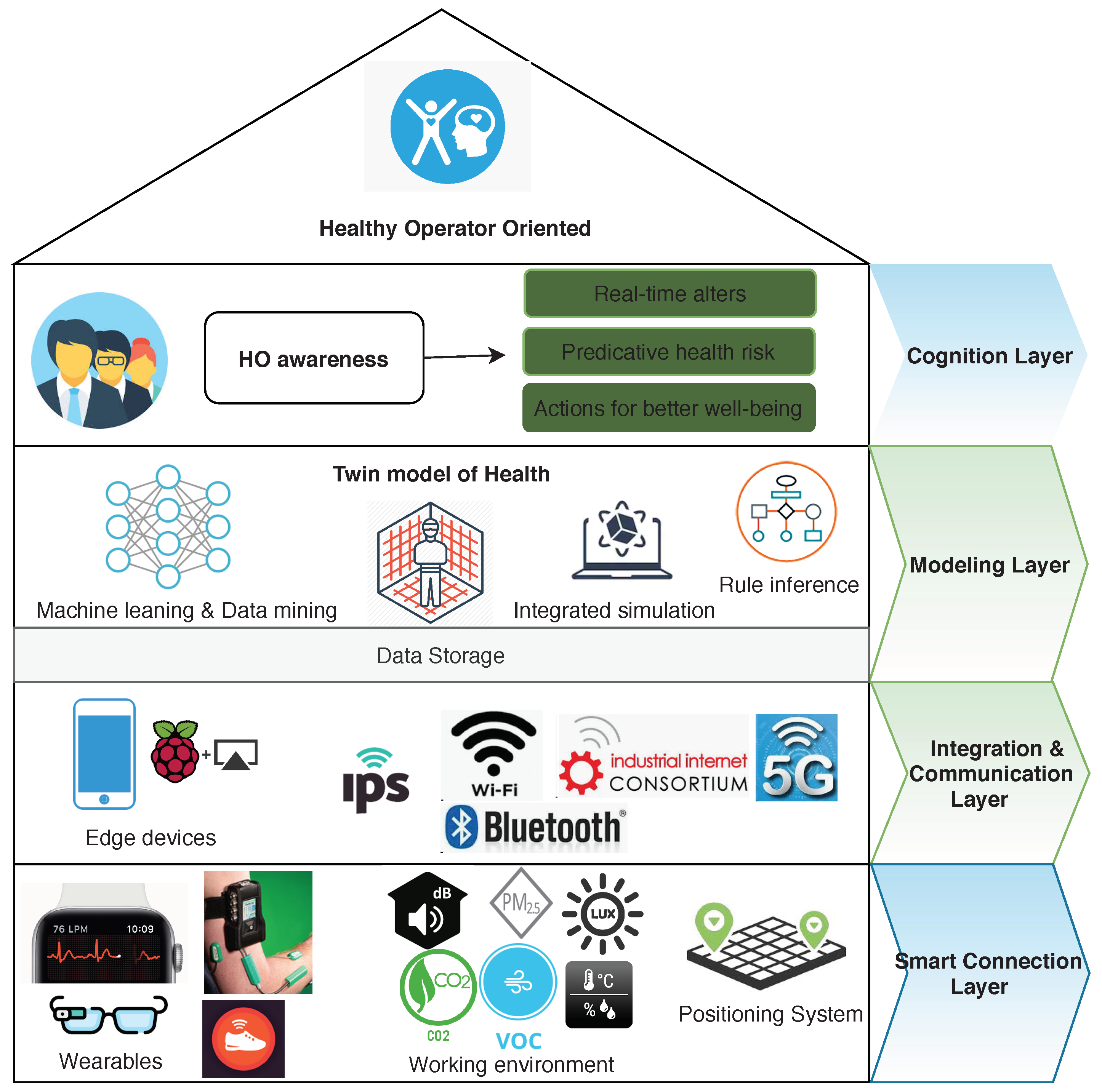
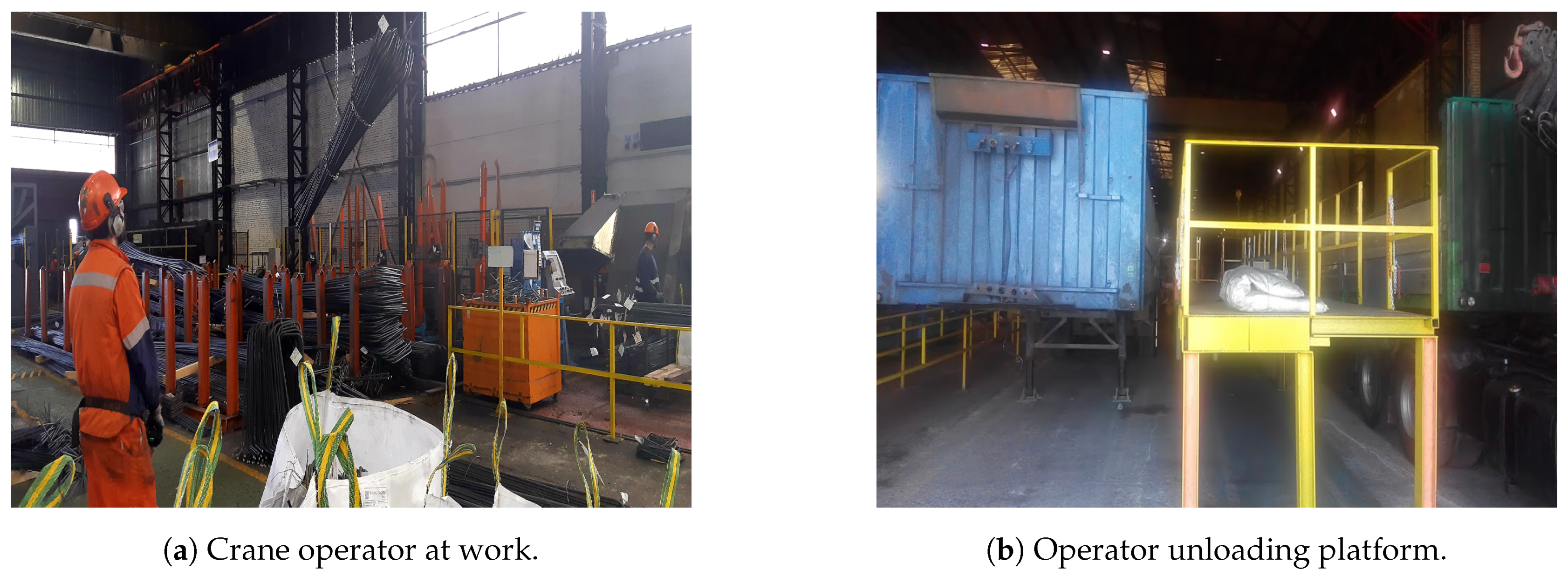

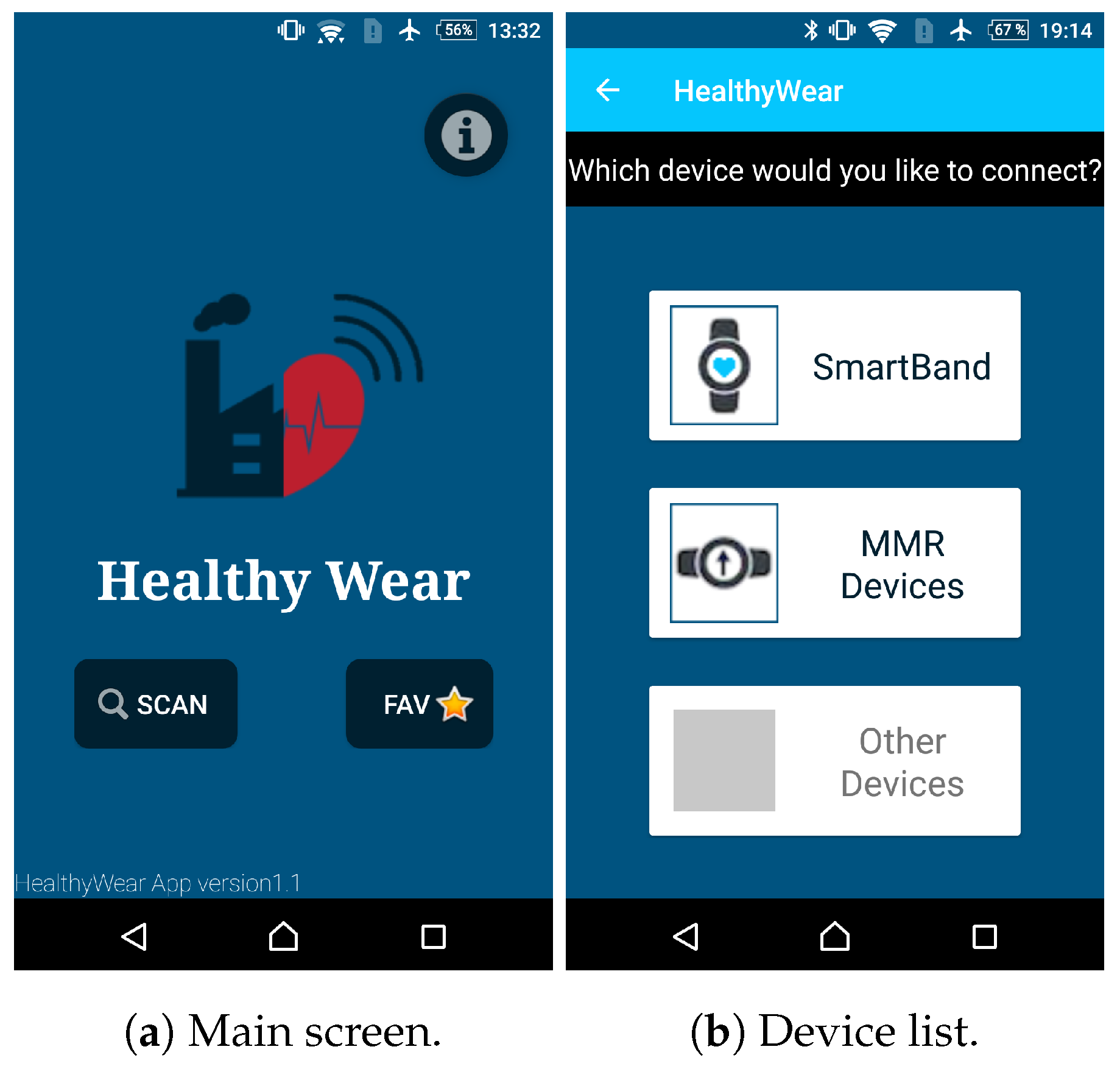
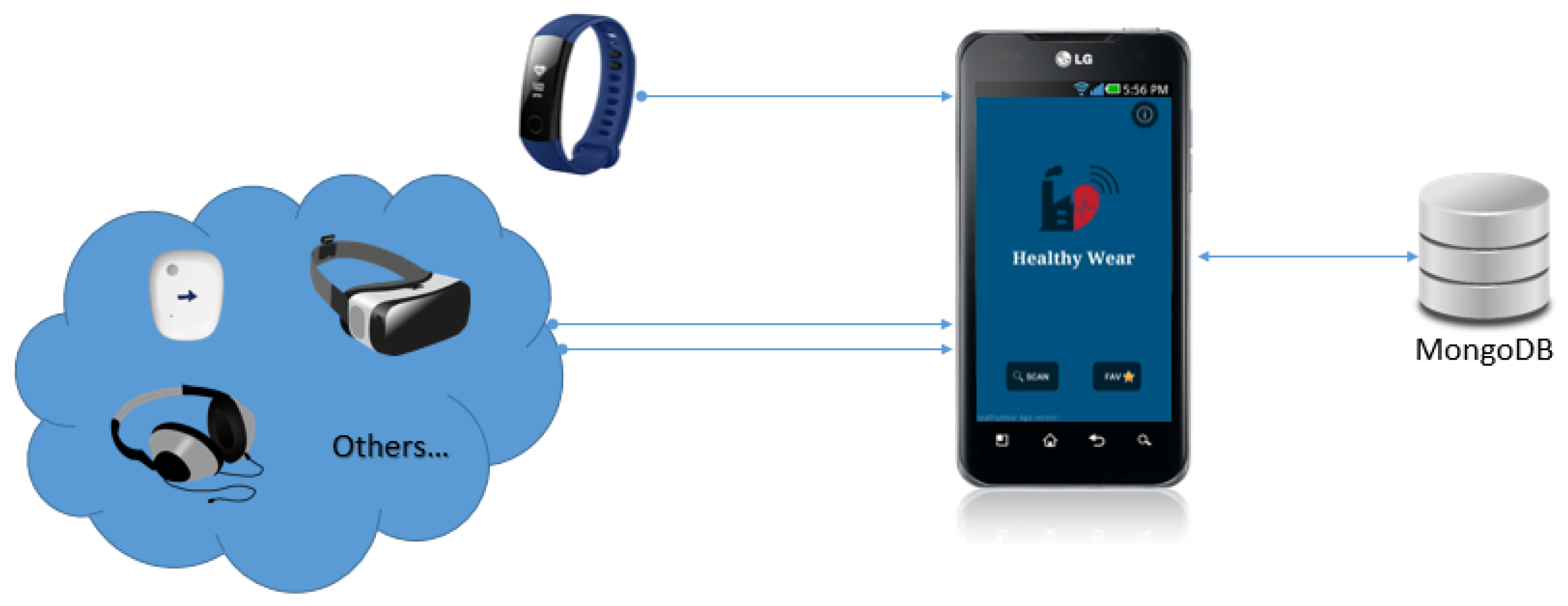
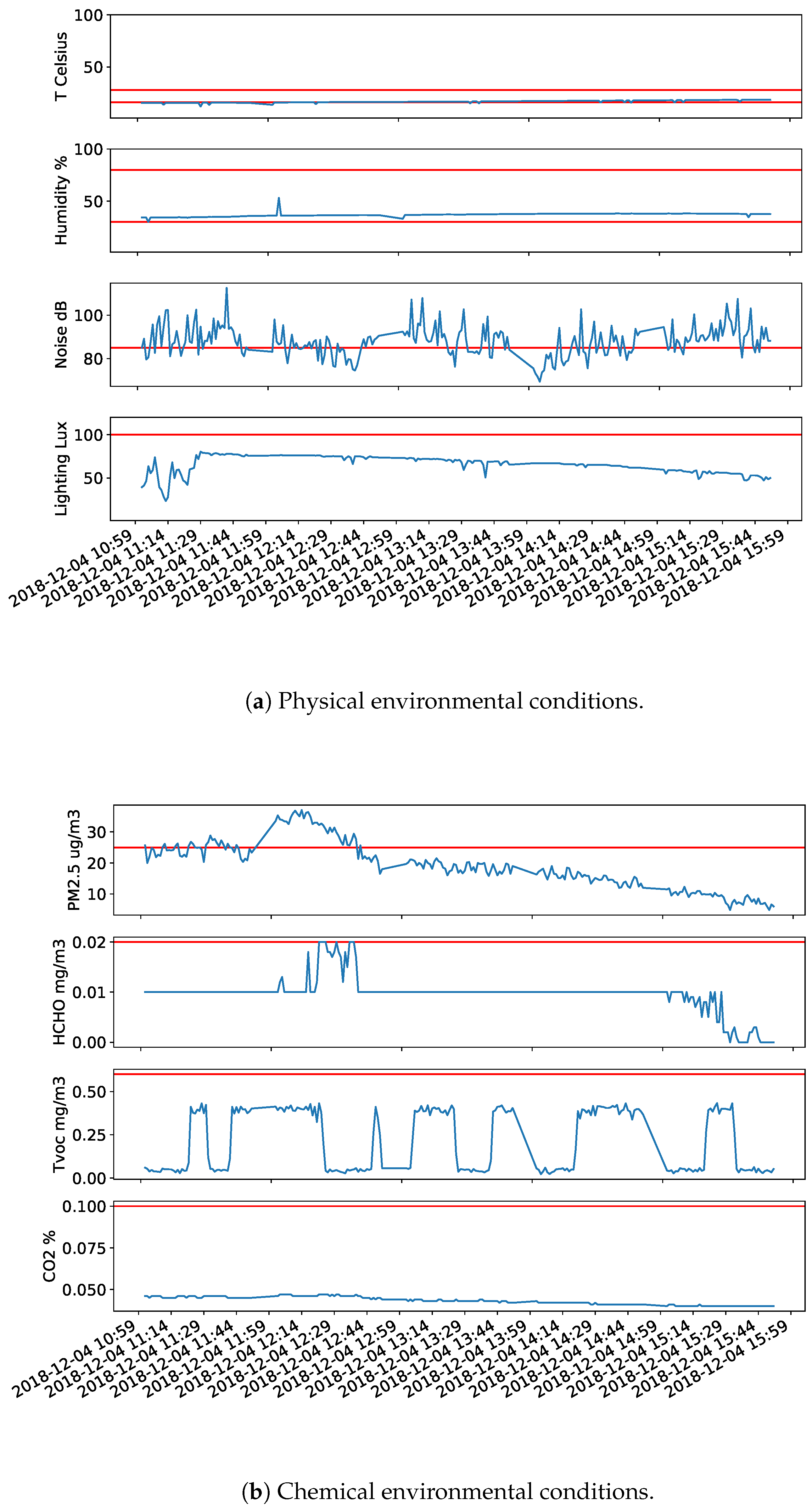
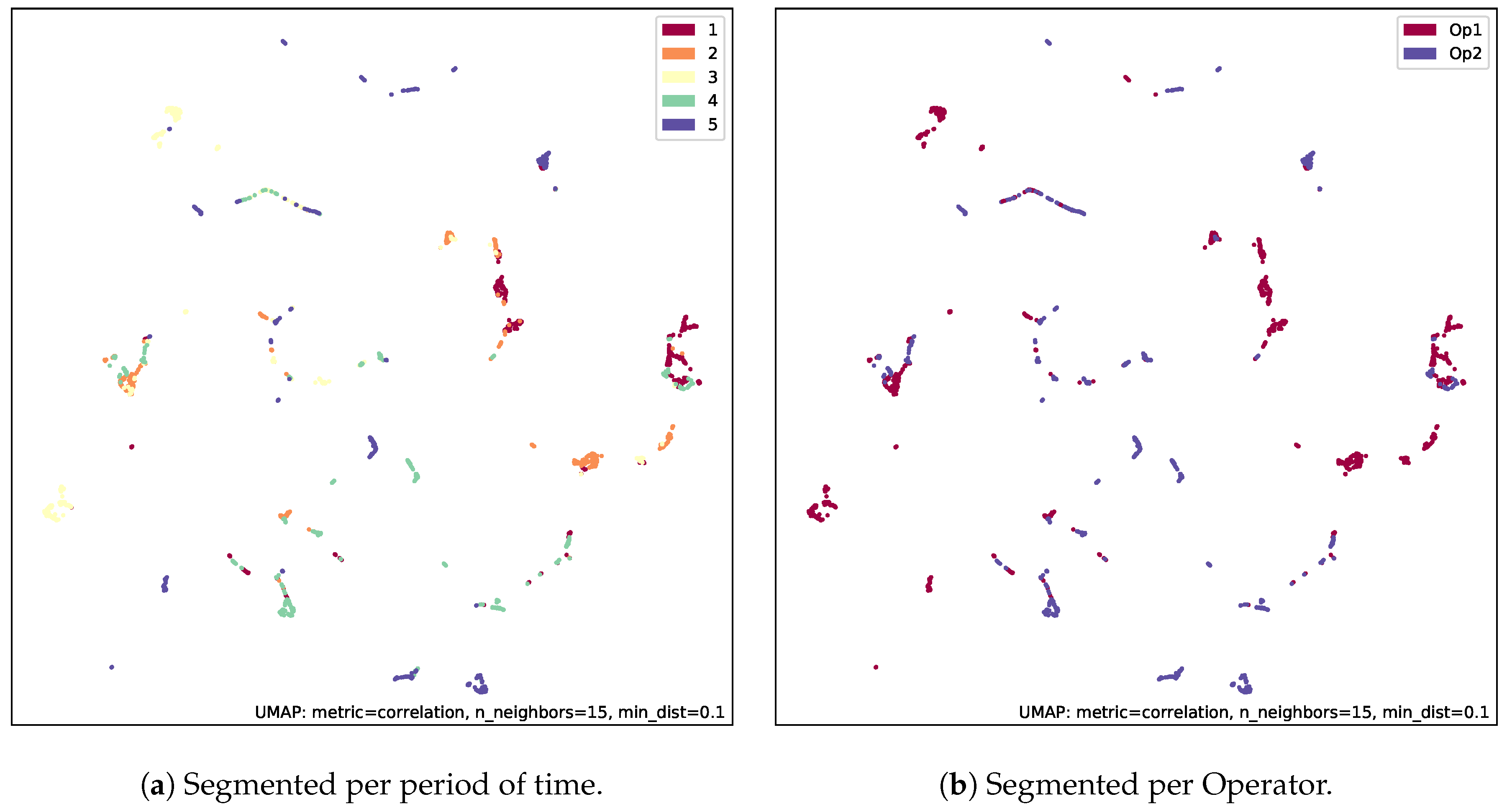
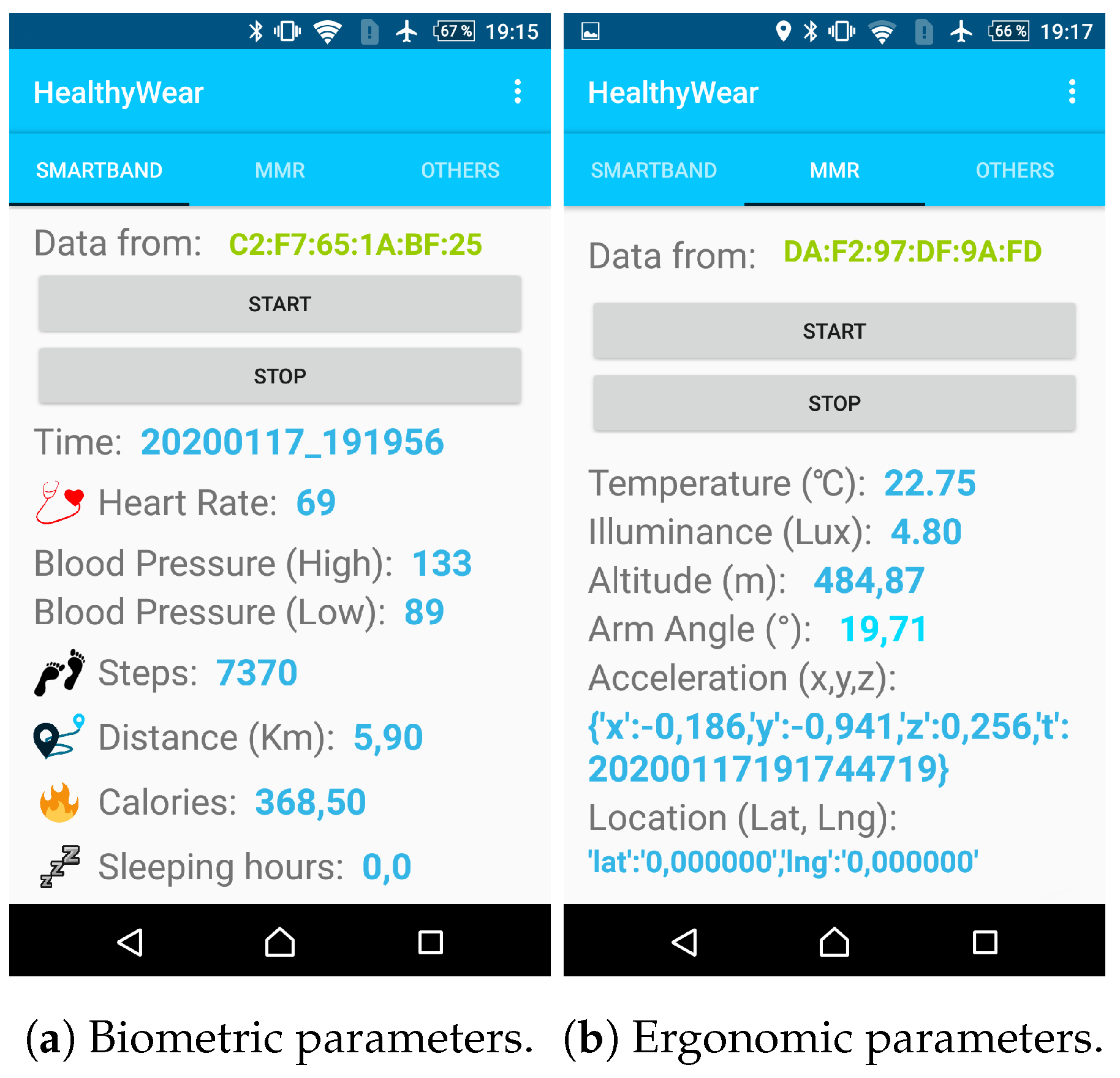
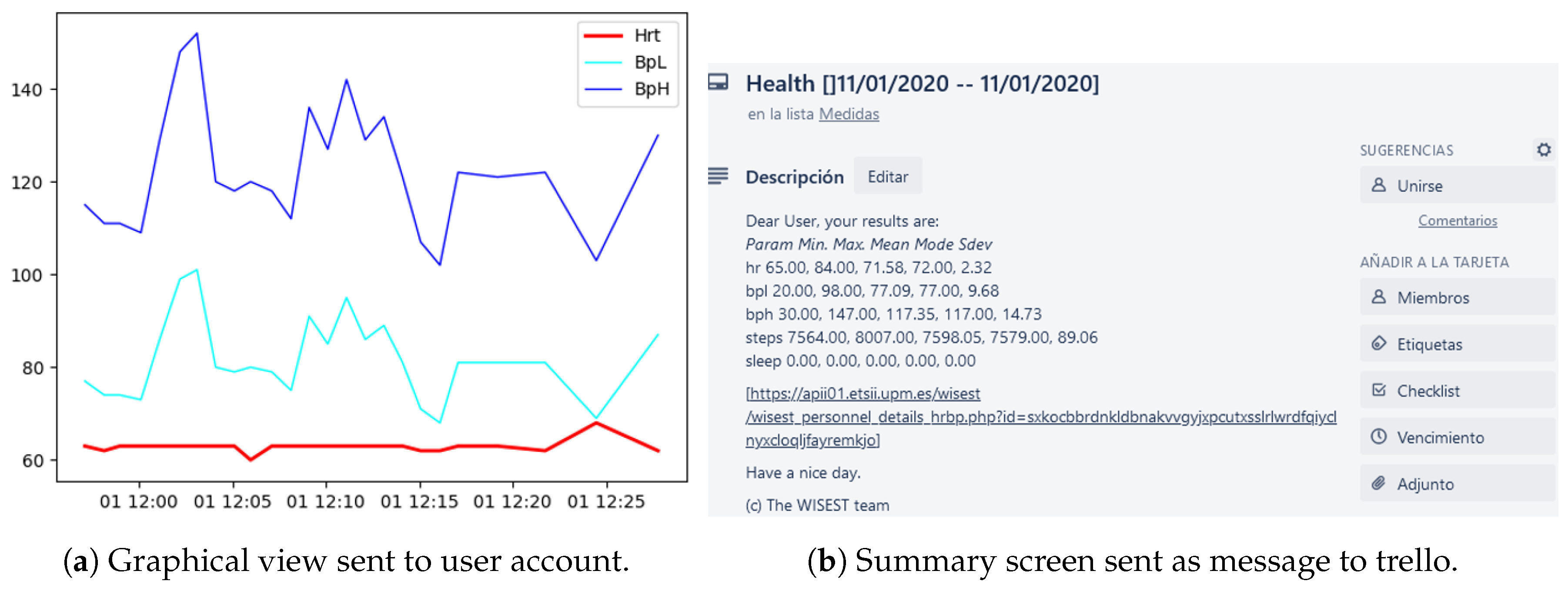
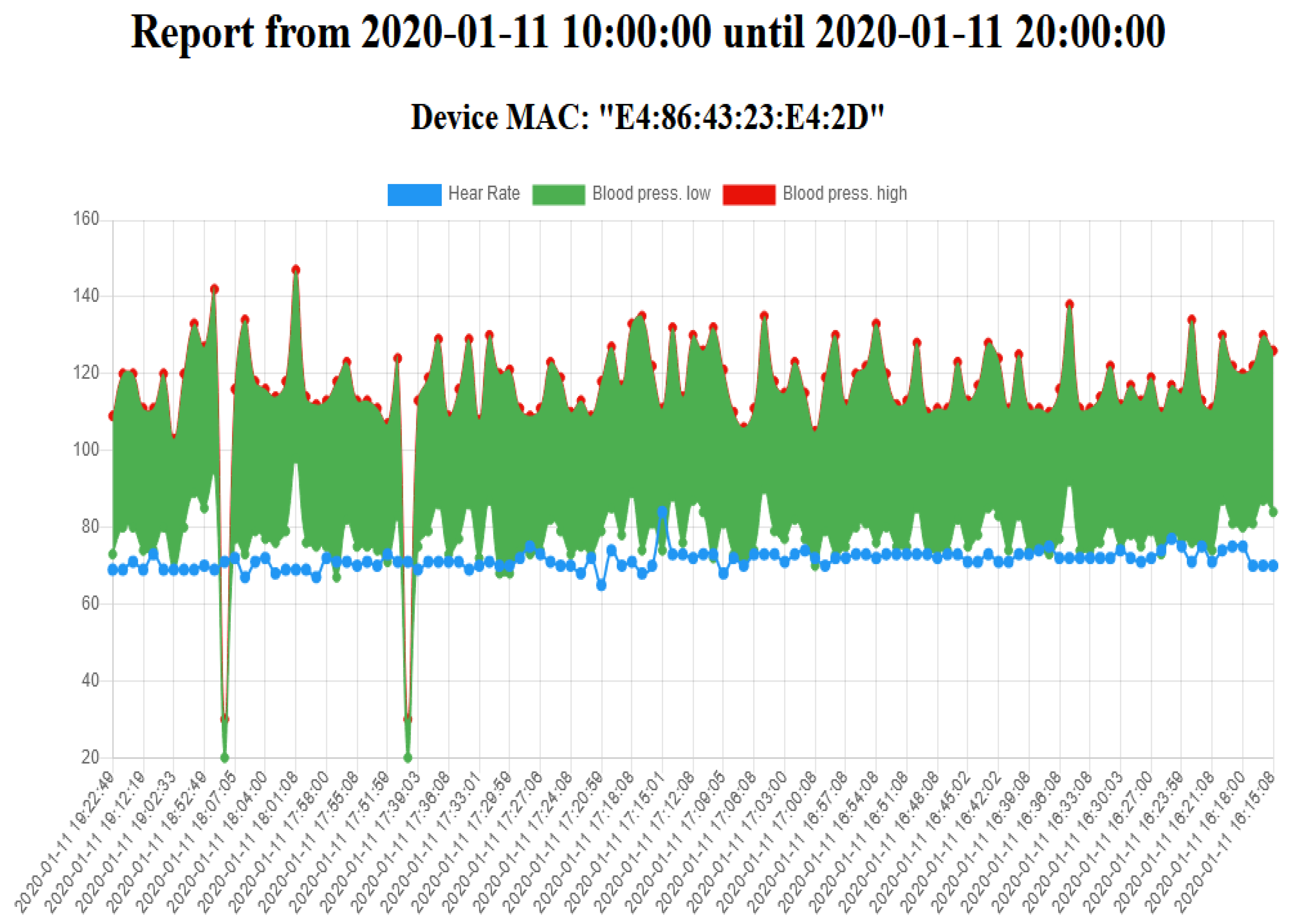
| Entity | Message |
|---|---|
| crane operator | { “Ontology”:”https://bit.ly/2OxeEkO”,”object”:”vcard”,”fn”:”José Luis Fernández”, ”nickname”:”Jose”,”hasEmail”:”mailto:perpalper@gmail.com”, “Gender”:”Male”,”bday”:”1988-06-23”,”adr”:”José Gutiérrez Abascal 2, 28006, Madrid” } |
| environmental situation | {“Ontology”: “AIR_POLLUTION_Onto”, “object”: “airPollutants”, “deviceId”: “Airmonitor1”, “PM”: “25 ug”, “CO2”: “0.04%”, “VOC”: “0.4 mg, “NOX”: “0”, “Timestramp”: “09/08/2019 09:10:00”} |
| stress factor | {“Ontology”: “HUMAN STRESS ONTOLOGY”, “object”: “Measurements”, “deviceId”: “Hband1”, “Timestramp”: “09/08/2019 09:10:00”, “stressPhysiology”: [ {“heartRate”: “80”, “bloodPressureHigh”: “120”, “bloodPressureLow: “70”}]} |
| position | {“Ontology”: “ILONA”, “object”: “Position”, “deviceId”: “Crane1”, “Coordinate”: [{“x”:”40.342712”, “y”:”-3.123472”, “z”: “605.85”}], “Timestamp”: “09/12/2019 10:10:00”} |
| Rule Antecedent | Confidence | Support | Lift |
|---|---|---|---|
| ’Arm angle:UP FRONT’ AND ’High Blood Pressure:Intense’ AND ’Heart Rate:Moderate’ | 1.0 | 5.9% | 3.86 |
| ’Sound Level:Noisy’ AND steps:Low AND Arm angle:UP FRONT AND ’High Blood Pressure:Intense’ | 1.0 | 6.27% | 3.86 |
| ’steps:Low’ AND ’HCHO:Relative Moderate’ AND ’High Blood Pressure:Intense’ | 0.84 | 10.0% | 3.85 |
© 2020 by the authors. Licensee MDPI, Basel, Switzerland. This article is an open access article distributed under the terms and conditions of the Creative Commons Attribution (CC BY) license (http://creativecommons.org/licenses/by/4.0/).
Share and Cite
Sun, S.; Zheng, X.; Gong, B.; García Paredes, J.; Ordieres-Meré, J. Healthy Operator 4.0: A Human Cyber–Physical System Architecture for Smart Workplaces. Sensors 2020, 20, 2011. https://doi.org/10.3390/s20072011
Sun S, Zheng X, Gong B, García Paredes J, Ordieres-Meré J. Healthy Operator 4.0: A Human Cyber–Physical System Architecture for Smart Workplaces. Sensors. 2020; 20(7):2011. https://doi.org/10.3390/s20072011
Chicago/Turabian StyleSun, Shengjing, Xiaochen Zheng, Bing Gong, Jorge García Paredes, and Joaquín Ordieres-Meré. 2020. "Healthy Operator 4.0: A Human Cyber–Physical System Architecture for Smart Workplaces" Sensors 20, no. 7: 2011. https://doi.org/10.3390/s20072011
APA StyleSun, S., Zheng, X., Gong, B., García Paredes, J., & Ordieres-Meré, J. (2020). Healthy Operator 4.0: A Human Cyber–Physical System Architecture for Smart Workplaces. Sensors, 20(7), 2011. https://doi.org/10.3390/s20072011








